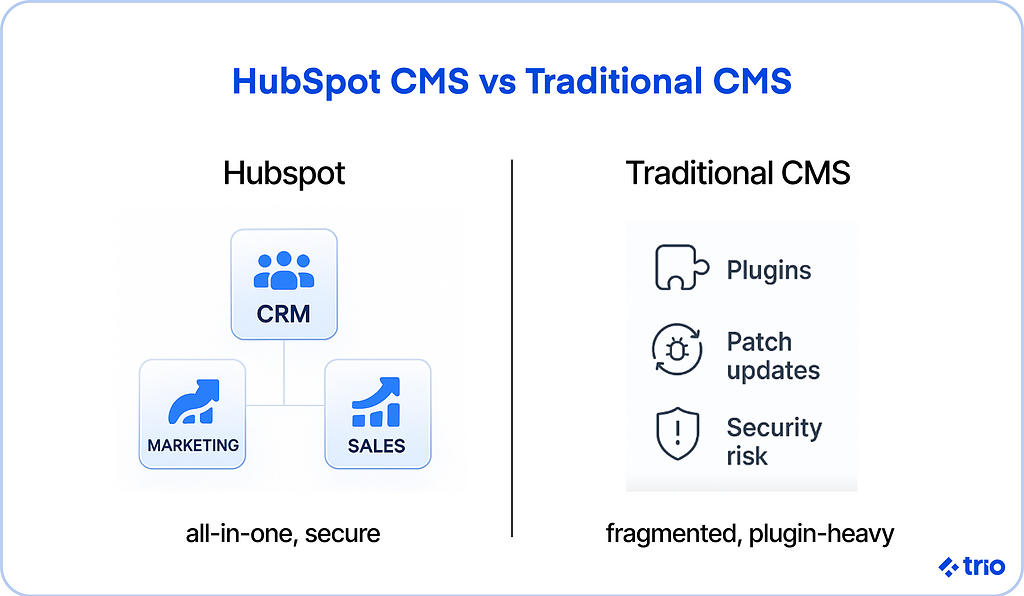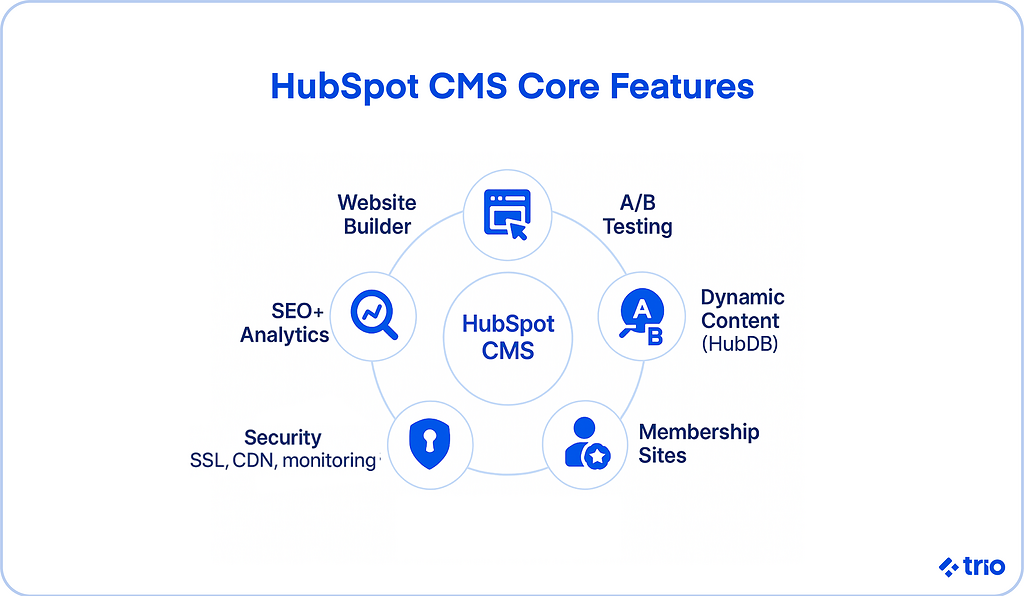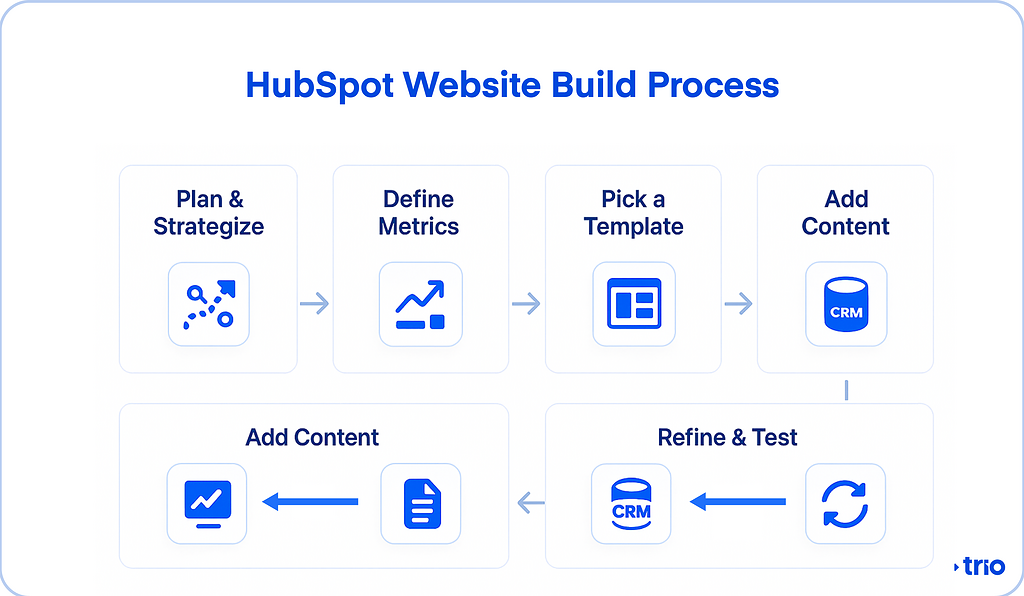Just about every business needs a website. There’s really no way around it. Put yourself in the shoes of one of your customers and imagine how they might discover your brand these days.
There’s a buyer’s journey that takes place for every service or product provided by businesses. Adding an item to a cart and making a purchase – in a figurative sense – is simply the end of this journey.
Buyers must be presented with a series of logical and emotional appeals to ensure that whatever you’re offering can fulfill their needs. Your content management system (CMS) is one way to guide the user experience through these appeals.
Although WordPress powers much of the web, HubSpot powers the highest traffic sites, and these are the metrics you want to pay attention to. HubSpot CMS can take you above and beyond when it comes to marketing your content.
Today, CMS Hub is available in three tiers (Free, Starter, and Professional) as well as enterprise options, making it accessible to both small businesses and large organizations.
Other options often require third-party plugins, which create additional risks. However, depending on the plan you choose, HubSpot offers everything needed to provide an all-in-one solution.
It is truly a comprehensive tool, integrating content management with CRM, marketing, and sales to streamline business growth. Therefore, if you are seeking an all-in-one solution, this may be the ideal option for your business.
If you’ve reached the same conclusion, your next step is to learn how to build and manage your HubSpot CMS. Well, you’ve come to the right place. The following guide provides a comprehensive overview of how to utilize HubSpot CMS to its full potential. Stay tuned!
If you need HubSpot developers, you’re in the right place. Our experienced developers can help you with all your web development needs, helping you create something truly valuable.
Are you ready to start your development project?
We have the developers you need to take your development project in the right direction.
Companies are proven to grow their business faster with Trio.
What Is HubSpot CMS?
A CMS is a system for creating, managing, and hosting content online. HubSpot has always specialized in growth in business and marketing. Still, it was only this year that loyal users and newcomers alike were introduced to the HubSpot CMS, alternatively called CMS Hub, at the Professional and Enterprise levels.
HubSpot CMS is the proposed solution to other CMS software that, although it gets the job done, requires heavier maintenance and more hoops to jump through. Speed, security, and scalability are among the primary advantages of the HubSpot CMS.
A traditional CMS can provide a base for publishing tools, user management, themes, media management, compliance, and basic optimization.
CMS Hub does the same, but amplifies every process by integrating it with HubSpot’s customer-relationship management (CRM) tool to reimagine the buyer’s journey. This reimagining is not only concerned with content management but also with marketing, sales, and customer service.
It also simplifies the technical management of your website, making it suitable for businesses that prioritize both user experience and operational efficiency.
Your customers will be able to access your content on a visually appealing and user-friendly website. You’ll be able to target them directly for marketing purposes, and they’ll have multiple channels from which they can get in touch with you.
Website management, increasing web traffic, and updating your website are easier than ever, thanks to HubSpot CMS.

What Can You Do with HubSpot CMS?

One of the primary reasons companies choose HubSpot CMS Hub is that it empowers marketing teams to build and manage their websites without relying on developers for every update.
We have also found that HubSpot CMS enables businesses to scale easily as they grow, which is a critical consideration. This is largely thanks to its powerful features, such as dynamic content and A/B testing.
With Trio, businesses can hire developers who provide them with the necessary tools to achieve their goals and have autonomy over their own success.
While it’s clear that HubSpot CMS promises results, if you care about the details, then this claim needs to be supported by hard facts.
Take this opportunity to learn more about the specific features that HubSpot CMS can offer.
1. Create a Website
Before you get started, you’ll likely want to ensure that you have a website up and running in the first place. This should be the very first step in any HubSpot endeavor. HubSpot developers can use the HubSpot CMS CLI and Node.js to configure local development tools.
Marketers will find that CMS Hub is a flexible platform for creating pages and publishing content, largely due to its intuitive drag-and-drop features.
Templates and modules, which are integral to building a unique website, can also be employed. The option to create fully customized templates and themes for your more advanced needs.
Developers still have control through CSS, HubL, and the HubSpot CLI, making it easy to create branded experiences that scale.
HubSpot CMS gives you the best of front-end development, but you won’t have to start from scratch. This means marketers, developers, and your business can focus on attracting customers rather than building from the bottom up, whether you are a beginner or have an experienced team on hand.
2. Run A/B Tests On Your Pages
HubSpot doesn’t fall exactly into the realm of software development, but developers can be a helpful and sometimes necessary resource to your website development. Similarly, testing – a well-maintained practice for creating bug-free, high-quality software – will have the same effect on ensuring your HubSpot website meets standards.
One notable feature, in particular, is A/B testing. Testing is built directly into CMS Hub.
This means you can run multiple variants of a web page against each other and present them to web visitors. This also applies to language variants.
At the Enterprise tier, adaptive testing automatically rotates up to five variations and learns which performs best over time, reducing guesswork.
3. Create Smart and Dynamic Content
HubSpot CMS integrates deeply with HubSpot CRM, meaning you can personalize content for different audiences automatically.
Smart CTAs, smart forms, and content rules let you serve different versions of a page based on visitor attributes like lifecycle stage, location, device, or referral source.
Dynamic content is also incredibly important as it allows you to enhance personalization, which is key to improving customer engagement.
HubDB, HubSpot’s clever name for its relational database represented in a table much like a spreadsheet, provides the vessel for dynamic content. Like any database, this allows for the storage of data, which can determine how and what content is delivered.
You can query data via the HubDB API or use HubSpot’s HubL markup tags. This is another area where developers will be particularly helpful. The ability of developers to leverage HubDB for more complex, dynamic functionality can be quite useful.
4. Create Membership Sites
Personalized content is at the core of a successful marketing strategy. This is the essence of a buyer’s journey. CMS Hub Enterprise allows user membership, enabling you to create content tailored to each site visitor.
Market segmentation likely plays a big part in how you target customers. Memberships make that targeting all the more worthwhile. You can even create business-specific pages, such as ‘My Events,’ so users can access information about their previous activities.
5. SEO and Performance Optimization
SEO recommendations are built directly into the content editor, helping you optimize pages as you build them.
HubSpot also supports Google AMP, multi-language content, and built-in site analytics.
Combined with HubSpot’s CDN, your site loads quickly worldwide.
6. Security and Reliability
Every CMS Hub plan includes a free SSL certificate, global CDN, 24/7 monitoring, and a 99.99% uptime SLA.
With HubSpot’s closed-source framework, businesses avoid the plugin vulnerabilities that often plague WordPress.
This is especially important if you are working in a niche like fintech, where any downtime or any leaks in security can be enough to sink your business.

Why Should You Use HubSpot CMS?
Unlike other CMS software, HubSpot CMS Hub works natively with HubSpot CRM, marketing, and sales tools. This gives you an all-in-one platform for building, optimizing, and scaling your website.
Our developers at Trio can help your business optimize HubSpot CMS’s CRM integration to ensure the platform is tailored to meet your specific marketing and customer engagement goals.
However, even with the help of experienced developers like those found at Trio, that doesn’t mean it’s foolproof. Every great technology is worth proper analysis, and you deserve to know about its disadvantages just as much as its advantages.
Advantages of HubSpot CMS
Many of the advantages of CMS Hub underscore the fact that HubSpot CMS offers multiple approaches to content management. It aims to make things easier for business managers who not only need software for hosting and publishing content, but also for marketing purposes.
All-in-One Growth Platform
Instead of piecing together a stack of plugins and third-party tools, you can manage your website, email marketing, landing pages, and sales funnels in one place. This means less time spent on maintenance and more time focused on growth.
Responsive Design & Drag-and-Drop Builder
HubSpot’s design manager and upgraded drag-and-drop editor (2023–2024 updates) make it easier than ever for marketers to build responsive sites without coding. Developers can still dive deeper with HubL and custom modules when needed.
Personalization & Smart Content
HubSpot’s personalization engine remains one of its strongest selling points. You can serve different content, CTAs, or forms based on CRM data, device, or lifecycle stage. This creates tailored experiences for every visitor.
SEO & Analytics Built In
HubSpot CMS automatically provides SEO recommendations, on-page optimization tips, and integrated analytics — no plugins required. This makes it easier to monitor performance and iterate.
Security by Default
Every plan includes SSL, a global CDN, and 24/7 monitoring. Enterprise adds advanced features like custom CDN configuration, partitioning, and activity logging.
Scalability
Whether you’re a small business starting with CMS Hub Starter ($15/month per seat) or a global brand on Enterprise, HubSpot CMS is built to grow with you.
Disadvantages of HubSpot CMS
Don’t be fooled. CMS Hub does have some limitations. And it’s important to be cognizant of those limitations as you choose which CMS will bring your business the most growth.
Limited Design Flexibility Compared to Open-Source CMS
WordPress and Drupal offer thousands of themes and plugins. HubSpot CMS has fewer prebuilt themes, so businesses often need developer support for heavy customization.
Higher Cost at Scale
While Free and Starter are affordable, Professional and Enterprise plans can feel expensive compared to open-source platforms, especially for businesses that don’t leverage the built-in CRM and marketing tools.
Learning Curve for Developers
HubSpot’s templating language (HubL) and proprietary environment require developers to learn a new workflow. This can slow down onboarding compared to more widely used frameworks.
Content Recovery Limitations
HubSpot makes it easy to back up and restore content, but restoring full environments (templates, CSS, scripts) can still be challenging.
HubSpot CMS Hub Tiers & Pricing
As already mentioned, there are four different options.
For the free tools, you can have up to two users and get most of what you need to get started.
The Starter platform has essential marketing, sales, service, content, and data management software and starts at $15 per month. You may per seat, and can get better value if you pay annually, so it is no surprise that it is the most popular option according to HubSpot.
Professional is where it gets expensive at $1,450 per month for six seats. You get comprehensive marketing, sales, customer service, content, and data management software. Enterprise plans start at $4,700 for 8 users and seem to be customizable.
How To Create a HubSpot Website
Believe it or not, creating a HubSpot website is the easy part. Ensuring it performs well, attracts, engages, and delights customers to keep coming back for more is the hard part.

1. Plan & Strategize
The scientific process holds true to this day. Identifying the problem is always the first step. Knowing what you’re trying to fix is the first step in determining your goals and planning how to achieve them.
Take some time to create a content strategy that aligns with our business objectives. A content strategy should revolve around your audience and your brand. Think intentionally about the role search engine optimization (SEO) will have in your content. Hopefully, it’s a big one.
2. Create Metrics
Based on the goals you plan to achieve, you’ll want to get a better idea of what type of metrics you need to measure to track progress. This will include metrics such as traffic, leads, reach, click-throughs, and more.
3. Pick a Template
HubSpot has many templates. You can choose from the abundance, but if not, you can also create your own template. This is especially a good idea if your business has specific branding needs, as a custom template will ensure that your website stands out.
Keeping your website visually appealing should be a primary concern for maintaining the integrity of your business.
Building a website is about building brand awareness. But your brand must be unique. Utilize HubSpot CMS to craft a unique and visually appealing webpage for your content.
4. Add Content
This is probably the most important part. HubSpot CMS, after all, is a content management system. It’s a bit difficult to get specific here because the type of content you produce depends entirely on your industry.
Another factor to consider is how your writing will be perceived in terms of diction, tone, style, and other literary elements that may influence how readers interpret your content.
Some blogs aim to be straight-up salesy. Others are a hub of expert knowledge through a professional tone. A good number of blogs use informality to relate to readers while still conveying their point.
5. Integrate the CRM
Most, if not all, of HubSpot’s premier advantages are brought about through its CRM. Though you have the option to integrate the HubSpot CMS with other CRM software like Salesforce or Marketo, most HubSpot connoisseurs will contest that you can get the best of both worlds right at home with HubSpot.
Whichever way, CRMs are an excellent way to know what’s going on in the sales and marketing world of your business. Needless to say, it’s a necessity if you want growth for your business.
6. Refine & Test
HubSpot has a content staging area for testing your website before it even goes live. Ideally, you want everything to be functional. What’s more, once you start publishing, you’ll have a sense of what works and what doesn’t as far as your website’s performance is concerned. Adjust accordingly.
You will also need to use continuous testing beyond the initial launch to ensure that your website evolves in line with your audience’s changing needs and behaviors.
How To Migrate Content From Another CMS To HubSpot
HubSpot is gaining popularity by the day. Still, there are a few stragglers who want to enjoy the benefits of HubSpot CMS but are unsure about how to migrate their content.
The process is complicated. There are multiple things to keep in check, such as:
- maintaining URL structures on websites
- redirecting URLs to new sites
- keeping pages uniform and their descriptions matching
- keeping the same HTML markups like alt text and header types
- implementing domain forwarding
In contrast, the actual migration process is fairly simple. At least, it looks that way on paper. Here’s a breakdown:
- Set up a HubSpot template for your website, whether you choose from the premade ones available or hire a developer to make a custom one.
- Export data from your existing CMS into an XML file. This document should include all the metadata of your content, including the title, post, URL, author, data, tags, categories, meta description, featured image, and comments.
- Finally, import your blog posts to your HubSpot CMS.
Despite the migration process comprising only three steps, there is significant work that needs to be done in each step. More often than not, businesses employ developers to handle this part and mitigate any risk.
HubSpot CMS Alternatives
HubSpot isn’t your only choice. If, for some reason, HubSpot doesn’t excite you, there are more CMS platforms to go around. These are some popular contenders, along with HubSpot CMS, that are taking over the market.
However, before making your decision, consider the advantages offered by HubSpot’s integrated marketing and CRM capabilities. Consider that it could reduce the need for multiple external tools, whereas other CMS platforms may not.
WordPress
WordPress powers at least a third of the web. This statistic has been flaunted almost everywhere as a testament to its powerful nature. So what exactly can WordPress do?
Like HubSpot, WordPress is a CMS that can be used as a blog, e-commerce website, business website, event website, or anything else you might like. You should note that WordPress does not have a CRM attached, so it doesn’t have the same marketing features as HubSpot.
Many WordPress features are not built-in but can be garnered with approximately 58,000 plugins, which can be credited to WordPress’s dedicated contributors. As WordPress is open-source, there’s a lot of room for modification, whether that’s a plugin, theme, or something else to help you refine your website.
Joomla!
Joomla! isn’t as popular as WordPress, but it can do the same things for your business. Plus, it’s free and open-source! Based on PHP and MySQL, the learning curve for Joomla! is reportedly slight.
The Joomla! A framework is available for developers to use the CMS in a more advanced way. With it, developers can build a range of tools, including communication tools, business directories, data reporting tools, application bridges, and product catalogs.
One of the notable features of Joomla! is more flexibility for different content types and themes, in addition to better user management.
Drupal
Drupal is a CMS platform that boasts speed, scalability, and innovation. Although Drupal takes up less space on the web than its counterparts, it is associated with popular websites such as NBCUniversal and Weather.com.
Drupal is considered to be more extensible than other CMS software and, to that end, more complex. The trade-off is truly scalable web content management. Commerce is also a common use case for Drupal.
How To Hire a HubSpot Developer
You’ve probably noticed a few ways in which a developer can be useful to you in using the HubSpot CMS. They can develop apps with HubSpot’s APIs, create a theme, migrate your website, and really do anything else that comes to mind when software development is on the table. There’s no doubt about it: HubSpot developers are a good idea.
That said if you don’t have experience in HubSpot or technical expertise in general, finding a developer can be a difficult task. Anybody can list off skills on a piece of paper, but whether they can actually do the work and perform up to standard requires further evaluation.
Furthermore, you need to ensure that the developers you hire not only understand the technical aspects of HubSpot CMS but also the marketing side, so that they can leverage the platform’s full potential for your business growth.
Hiring developers is an important but exhaustive process. However, if you need assistance, Trio is here to help. There’s a useful guide available just for your pleasure!
How Much Is a HubSpot Developer?
According to recent Glassdoor reports, the median HubSpot developer makes $136,966 annually. Overall, salaries for HubSpot developers can range between $92,000 and $163,000.
Naturally, outsourcing your development needs is one way to lower costs and mitigate risk. This approach has been a popular method for achieving project goals over the past few years. And Trio is proud to support this method.

Elevate Your Team with Trio AI Talent
Empower Your Projects with Trio’s Elite Tech Teams
Hire a HubSpot Developer with Trio
Developers at Trio are well-versed in HubSpot technology. Integrating your CRM or migrating your website to HubSpot are a few examples of how Trio can help you.
Trio HubSpot developers are web developers trained to create custom websites and templates that ensure customer satisfaction. They’ve also thoroughly familiarized themselves with APIs and those of third parties.
At Trio, our HubSpot developers have your back.
We want to make HubSpot work for you. Not through trial and error, but with heavily trained and vetted developers who are right at your fingertips. Hire a HubSpot developer with Trio to start developing now.
FAQs
Is HubSpot CMS good for small businesses?
Yes, HubSpot CMS is suitable for small businesses because it allows you to build professional websites with built-in CRM tools, many of which are free or available for a small additional cost.
Does HubSpot CMS replace WordPress?
HubSpot CMS can replace WordPress for businesses that want built-in CRM, SEO, and marketing tools without relying on plugins.
How secure is HubSpot CMS?
HubSpot CMS is secure because it includes SSL, a global CDN, 24/7 monitoring, and advanced protections at the Enterprise tier.






